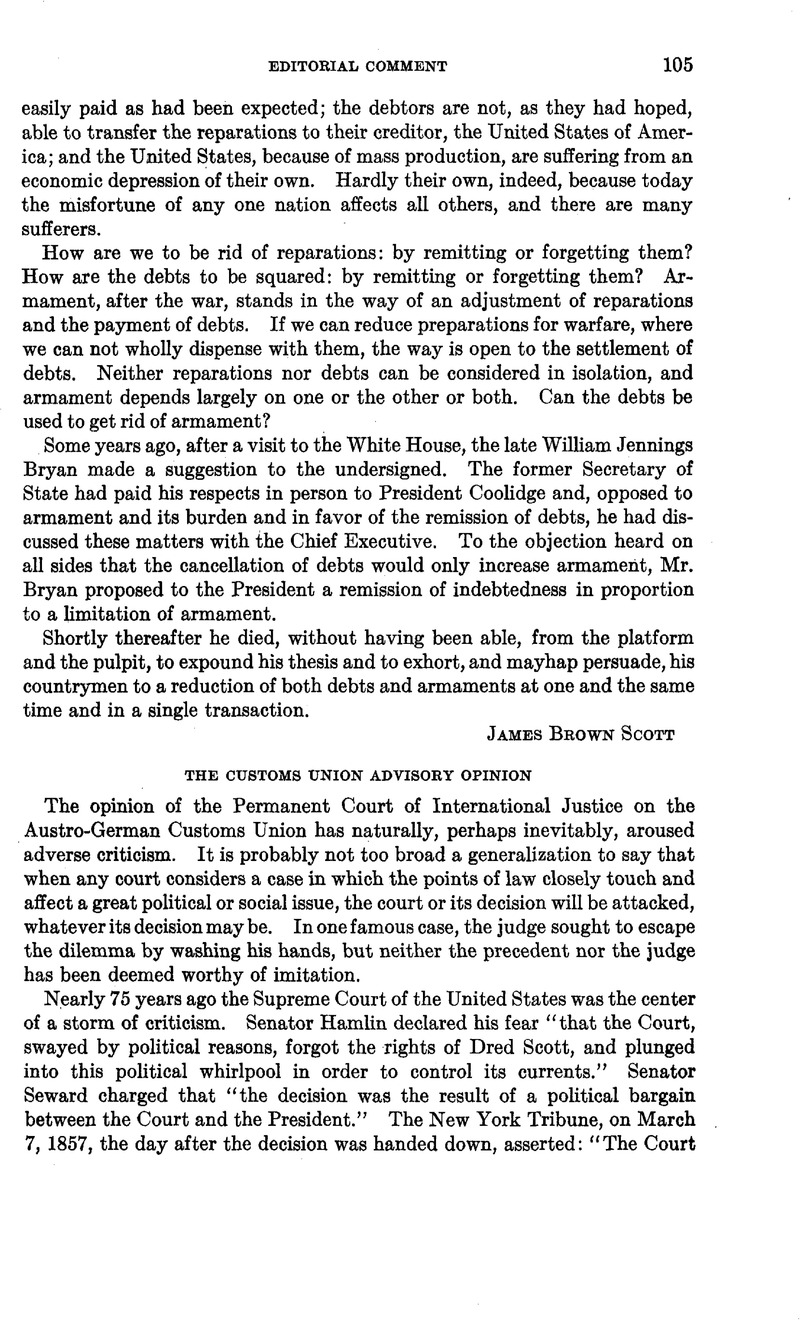Article contents
The Customs Union Advisory Opinion
Published online by Cambridge University Press: 12 April 2017
Abstract

- Type
- Editorial Comment
- Information
- Copyright
- Copyright © American Society of International Law 1932
References
1 See Warren, The Supreme Court in United States History, Vol. III, Chapter XXVI, passim.
2 One may recall, for example, the income tax cases, (1895) 157 U. S. 429, and 158 U. S. 602; and compare the stir in England over the House of Lords’ decision in the Taft Vale case dealing with trade unions, [1901] A. C. 426.
3 Mr. Justice Stone, in address to the American Bar Association, 1928, American Bar Association Journal, Vol. 14, pp. 428, 436. Compare Mr. Justice Holmes’ statement: “I get letters, not always anonymous, intimating that we are corrupt. Well, gentlemen, I admit that it makes my heart ache.” Holmes, Collected Legal Papers (1921), p. 292.
3a The close division of expert opinion in the United States on the merits of the question, is noted in the illuminating article by Mr. John W. Davis, “ The World Court Settles the Question,” which appeared as this Journal goes to press, in the Atlantic Monthly, January, 1932, page 119, 129.
4 Cf. “The Consideration of Facts in ‘Due Process’ Cases,” (1930) 30 Col. Law Rev. 360, and infra, note 7.
5 (1922) 262 U. S. 553.
6 (1897) 169 U. S. 466.
7 Compare the remarks of Mr. Justice Stone in his address to the American Bar Association, 1928, American Bar Association Journal, Vol. 14, pp. 428, 433: “Lawyers, who, in the presentation of a negligence case, would prove with meticulous care every fact surrounding the accident and injury, in this field too often go little beyond the challenged statute and the citation of authorities in supposedly analogous cases. The Court is thus often left to speculate as to the nature and extent of the social problems giving rise to the legislative problem, or to discover them by its own researches. Intimate acquaintance with every aspect of the conditions which have given rise to the regulatory problems are infinitely more important to the Court than are the citation of authorities or the recital of bare formulas.”
See also the following cases before the Supreme Court: Ambrosi v. U. S. (1902), 187 U. S. 1; Minnesota Rate Cases (1913), 230 U. S. 352, 402-411; Gulf C. & S. F. Ry. v. Texas (1918), 246 U. S. 58, and Missouri K. & T. Ry. Co. v. Texas (1918), 245 U. S. 484.
8 Both the majority and the minority take note of the historical events relative to Austro-German union. There is nothing peculiar in Judge Anzilotti’s position on thispoint. English and American courts take judicial notice of historical matters; see Wigmore on Evidence, Sec. 2580. “ . . . there is required a sharp discrimination as to what is fact and what is law. Some possible elements which are subject to judicial notice resemble both. Political problems present this situation.” Strahorn, “The Process of Judicial Notice” (1928) 14 Virginia Law Rev., pp. 644, 546.
- 1
- Cited by


